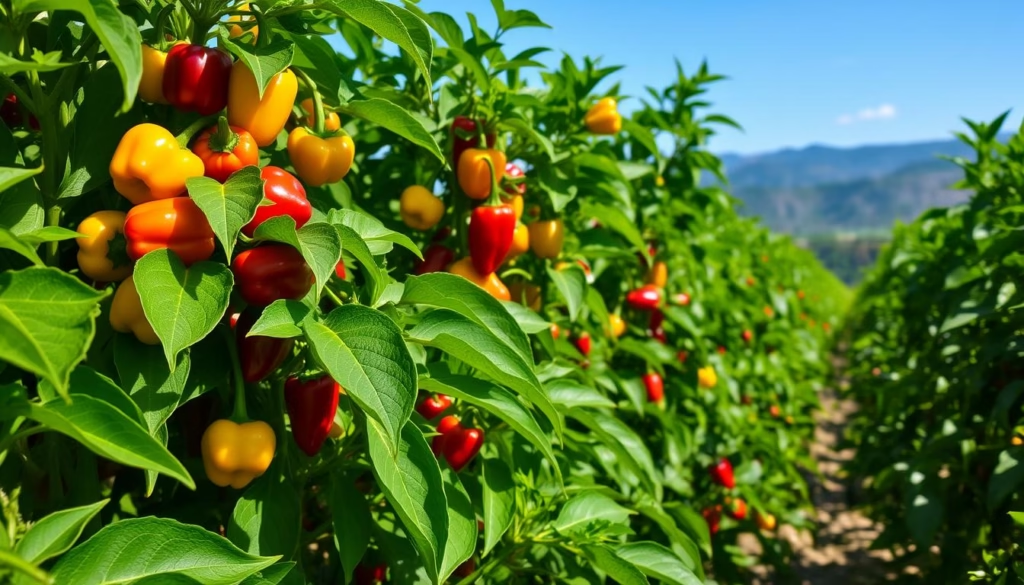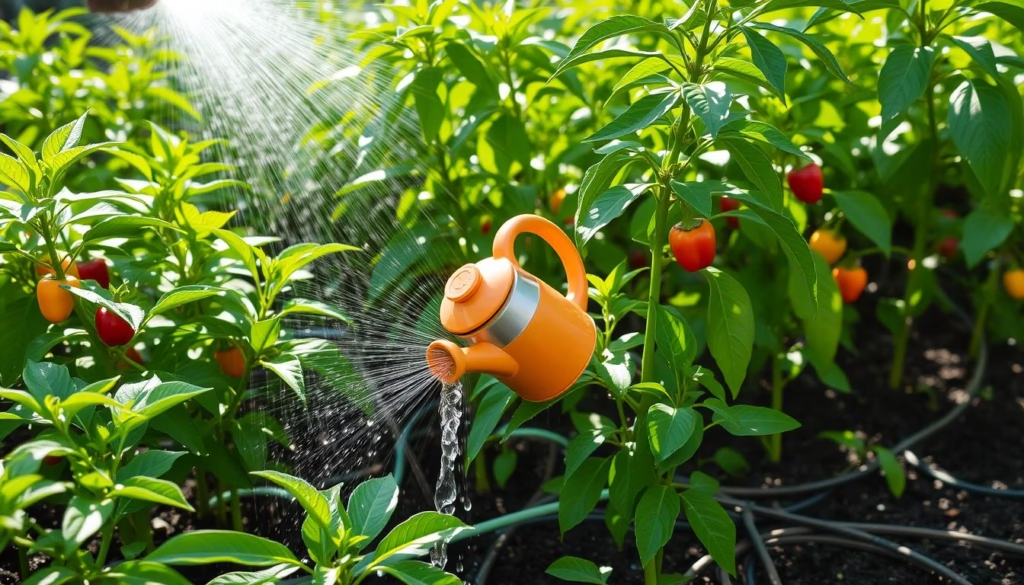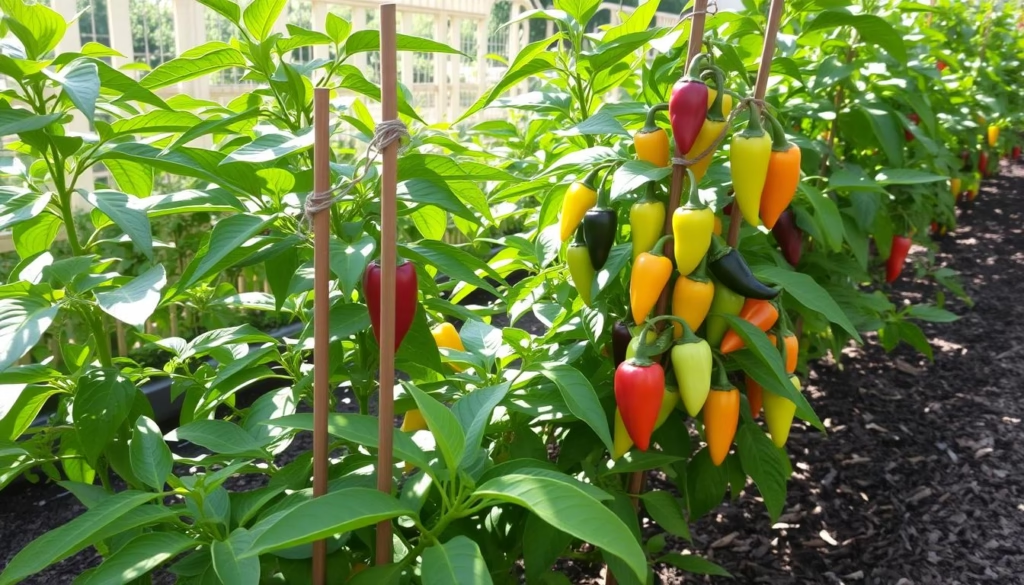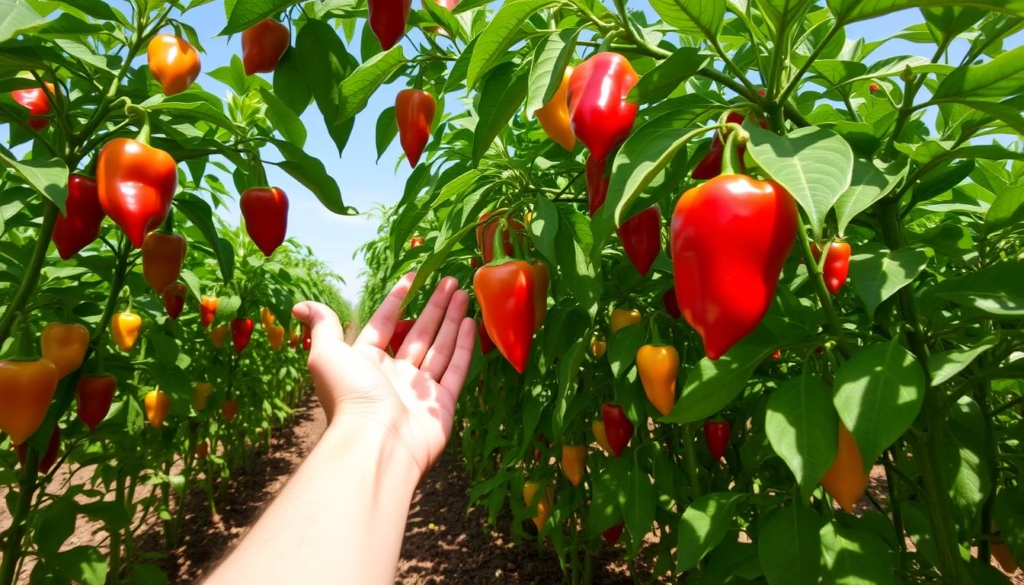Welcome to the world of pepper cultivation. Growing peppers at home is fun and rewarding. You can enjoy delicious and nutritious peppers all year round. It’s a great way to start with home gardening and master pepper cultivation.
Table of Contents
Starting your home gardening journey with peppers has many benefits. From planting to harvesting, it requires attention and a desire to learn. This guide will help you grow peppers like a pro and enjoy your hard work.

This comprehensive guide will teach you everything about growing peppers. You’ll learn about different varieties, harvesting, and storing your peppers. Whether you’re new or experienced, you’ll find helpful tips and insights for success in pepper cultivation and home gardening.
Introduction to Pepper Cultivation
Exploring pepper cultivation, you’ll discover various techniques and strategies. We’ll cover soil preparation, pest management, and more. With the right knowledge and skills, you’ll enjoy a bountiful harvest of delicious peppers and elevate your home gardening.
Key Takeaways
- Pepper cultivation is a rewarding experience that can provide you with a variety of delicious and nutritious peppers.
- Growing peppers is a great way to get started with home gardening.
- Mastering the art of pepper cultivation requires attention to detail and a willingness to learn.
- Understanding the different varieties of peppers is crucial for successful pepper cultivation.
- Proper techniques and strategies are necessary for growing healthy and thriving pepper plants.
- Home gardening can be a fun and rewarding experience with the right knowledge and skills.
Understanding Different Pepper Varieties
There are many pepper varieties to grow, like sweet, hot, and ornamental peppers. Each has its own look, taste, and growing needs. Knowing these differences helps you pick the best peppers for your garden and cooking.
Sweet peppers are perfect for snacks, salads, and adding crunch to meals. Hot peppers add spice to dishes. Ornamental peppers brighten up your garden with color.
Some popular pepper varieties include:
- Sweet bell peppers
- Jalapeno hot peppers
- Ornamental Thai peppers
Choosing the right peppers means a great harvest. You’ll add flavor, texture, and beauty to your garden and food. Whether you like sweet, hot, or ornamental peppers, there’s something for everyone.
With so many pepper varieties, you’ll find the perfect ones for your taste and garden style.
| Pepper Variety | Description | Use |
|---|---|---|
| Sweet Peppers | Mild, sweet flavor | Salads, snacking |
| Hot Peppers | Spicy, hot flavor | Spicy dishes, sauces |
| Ornamental Peppers | Decorative, colorful | Garden decoration |
Essential Growing Conditions for Successful Pepper Plants
To grow pepper plants well, you need to know what they need. This includes the right amount of sunlight, water, and nutrients. By making sure your plants have what they need, you can get a lot of peppers.
Some important things to think about for your pepper plants include:
- Soil quality and temperature
- Adequate sunlight and shading
- Watering schedules and moisture levels
- Fertilization and nutrient supplementation
By managing these growing conditions well, your pepper plants will do great. This is true whether you’re new to gardening or have been doing it for a while. Knowing what your pepper plants need is key to successful gardening.
When setting up the best spot for your pepper plants, pay close attention to details. Give them the right mix of sunlight, water, and nutrients. This will help you have a great gardening experience.
With the right growing conditions, your garden will be full of healthy pepper plants. Follow these tips to make your successful gardening even better. You’ll get a lot of tasty peppers.
| Factor | Optimal Condition |
|---|---|
| Soil Temperature | 70-85°F (21-29°C) |
| Sunlight | 6-8 hours of direct sunlight |
| Watering | Consistent moisture, but not waterlogged |
Preparing Your Garden Space
When growing peppers, garden preparation is crucial. You need to create a space that supports healthy growth. This means understanding the soil requirements and following spacing guidelines. This way, your plants will get off to a great start.
Choosing the right soil is key. Pepper plants thrive in well-draining, organic-rich soil. Test your soil to check its pH and nutrient levels. If needed, make adjustments. Also, think about container gardening if space or soil quality is a concern.
- Choose a location that receives full sun and has good air circulation
- Test your soil and make adjustments as needed
- Follow proper spacing guidelines to prevent overcrowding
- Consider container gardening as an option
By following these tips, you can create a garden that thrives. Always focus on soil requirements and spacing guidelines for the best results.
How to Grow Pepper from Seeds
Growing peppers from seeds is fun and rewarding. You start by planting seeds in a controlled space. This needs careful attention to light, water, and nutrients for the seeds to grow well.
For indoor seed starting, use a quality mix and keep the soil warm, 75-85°F. A heating mat or a warm spot can help. After germination, focus on seedling care, like supporting them as they grow.
Starting Seeds Indoors
- Use a good quality seed starting mix
- Keep the soil warm, around 75-85°F
- Provide adequate light, such as grow lights or a sunny windowsill
Germination Tips
To help seeds germinate, keep the soil moist but not too wet. A cloche or plastic bag can also help keep it humid. With the right conditions, you should see sprouts in 1-2 weeks.
Seedling Care
After seedlings emerge, focus on support and nutrients. Use a balanced fertilizer and provide support as they grow. Follow these steps for a strong start and a great harvest.
| Seed Starting Tips | Germination Tips | Seedling Care |
|---|---|---|
| Use a good quality seed starting mix | Keep the soil consistently moist | Provide support for the seedlings |
| Keep the soil warm, around 75-85°F | Use a cloche or a plastic bag to create a humid microclimate | Use a balanced fertilizer |
Transplanting Your Pepper Seedlings
When transplanting seedlings, it’s key to be gentle. You’ve cared for your pepper seedlings indoors. Now, it’s time to move them to their new home in the garden. This step is vital for their health and growth.
Start by hardening off your seedlings. This means slowly getting them used to outdoor conditions over 7-10 days. It helps them adjust without shock. Wait for a calm, mild day to transplant, avoiding hot weather or direct sunlight.
- Handle the seedlings by the leaves to avoid damaging the stems.
- Plant them at the same depth as they were in their pots, making sure not to bury the leaves.
- Water thoroughly after transplanting to settle the soil and provide enough moisture.
By following these steps, you’ll ensure a successful garden transplantation. Your pepper seedlings will thrive, leading to a great harvest.
Watering and Irrigation Techniques
Proper watering is key for your pepper plants’ health and growth. You must learn the best ways to water them. Using drip irrigation or soaker hoses can help water reach the roots directly, cutting down on evaporation and runoff.
It’s important to know how much water your pepper plants need. Different varieties need different amounts of water. Mulching helps keep the soil moist and cuts down on the need for constant watering. Organic mulch like straw or bark chips can cool and moisten the soil.
Effective Moisture Management
Managing moisture is vital to avoid overwatering, which can harm your plants. You can check soil moisture by feeling it with your finger or using a moisture meter. Adjust your watering based on what you find. Here are some tips for managing moisture well:
- Water your pepper plants in the morning so they can absorb it all day
- Don’t water the leaves to avoid fungal diseases
- Use a potting mix that drains well to avoid waterlogged soil

By using these tips and the right irrigation methods, your pepper plants will get the moisture they need to thrive. Keep an eye on the weather and adjust your watering schedule to avoid too much or too little water.
| Watering Technique | Benefits |
|---|---|
| Drip Irrigation | Reduces evaporation and runoff, delivers water directly to the roots |
| Mulching | Retains moisture in the soil, reduces the need for frequent watering |
| Soaker Hoses | Delivers water directly to the roots, reduces evaporation and runoff |
Fertilizing Your Pepper Plants
Fertilizing peppers is key to their growth and health. A balanced fertilizer provides the nutrients needed for strong plants. This is crucial for a good harvest.
To feed your pepper plants right, follow these tips:
- Choose a fertilizer rich in phosphorus for fruit growth
- Start fertilizing when plants are about 6 inches tall
- Always follow the fertilizer package’s instructions to avoid harming your plants
Fertilizing peppers is vital for their health and yield. The right nutrients ensure a rich harvest of tasty peppers. Pick a fertilizer that fits your garden’s needs and use it as directed.
For more on pepper nutrition and fertilizing, talk to a gardening expert or look online. With the right fertilizer and care, your pepper plants will thrive. Enjoy a bountiful harvest of delicious peppers for months.
| Fertilizer Type | Nutrient Content | Application Rate |
|---|---|---|
| Balanced Fertilizer | 10-10-10 NPK | 1 tablespoon per gallon of water |
| High Phosphorus Fertilizer | 10-20-10 NPK | 1 teaspoon per gallon of water |
Supporting Your Growing Peppers
As your pepper plants grow, they may need support to avoid falling over. This is where supporting peppers becomes key. You can use staking methods and caging options to help.
For staking methods, you can use stakes for each plant or a trellis for many. When using stakes, tie the plant gently to avoid harming the stem.
Choosing the Right Support System
For caging options, tomato cages or pepper cages are great. They give a strong base for the plant to grow around. You can also use a fence or stakes with twine for support.
Here are some benefits of using supporting peppers methods:
- Prevents breakage and damage to the plant
- Keeps the plant upright and secure
- Encourages healthy growth and fruit production

By giving your pepper plants the right support, they’ll grow strong and healthy. Choose the best staking methods or caging options for your plants. Happy growing!
| Support Method | Benefits | Drawbacks |
|---|---|---|
| Staking | Easy to set up, provides individual support | Can be time-consuming, may not be suitable for large plants |
| Caging | Provides sturdy support, encourages healthy growth | Can be expensive, may not be suitable for small plants |
Common Pepper Plant Problems and Solutions
When you grow pepper plants, you might face several challenges. These can be due to pests, diseases, or the environment. It’s important to spot and fix these issues quickly to get a good harvest. Keeping pests away, preventing diseases, and managing the environment are key.
To tackle common problems, you can take a few steps. For pests, try using beneficial insects or organic controls. To avoid diseases, rotate crops and keep things clean. For environmental issues, make sure your plants have the right conditions and watch the weather.
Identifying Common Issues
- Pest infestations, such as aphids or whiteflies
- Diseases, like powdery mildew or root rot
- Environmental stressors, including drought or excessive moisture
Knowing about these issues and acting early can help your pepper garden thrive. Regular checks and care are essential. This way, you can spot problems fast and fix them with the right strategies.
Implementing Solutions
To solve common pepper plant problems, try these approaches:
| Issue | Solution |
|---|---|
| Pest infestations | Introduce beneficial insects or use organic pest control methods |
| Diseases | Implement crop rotation and proper sanitation techniques |
| Environmental stressors | Provide optimal growing conditions and monitor weather forecasts |
By following these tips and staying alert, you can overcome pepper plant problems. Always focus on managing pests, preventing diseases, and taking care of the environment. This will help your pepper garden stay healthy and productive.
Harvesting Your Peppers
As you near the end of growing peppers, knowing when to harvest peppers is key. The timing harvest affects the taste, texture, and quality of your peppers. Harvesting them right lets you enjoy your homegrown peppers at their peak.
Here are some tips for a successful harvest:
- Check the color: Most pepper varieties will turn from green to their final color when ripe.
- Check the size: Peppers should be firm and have reached their full size.
- Check the stem: A ripe pepper will have a dry, brown stem.
When picking, handle your peppers gently. Don’t pull or tug on the plant, as it can harm the stem or roots. Use scissors or a sharp knife to cut the pepper from the plant. Leave a small piece of stem attached. This helps prevent water from entering the stem and reduces rot risk.

By following these tips and techniques, you’ll enjoy your freshly harvested peppers in many dishes. Use them in salads, stir-fries, sauces, and marinades. Remember to store your peppers properly to keep them fresh and flavorful.
Storing and Preserving Your Pepper Harvest
After you harvest your peppers, you’ll want to keep them fresh for the whole year. Food preservation is key to keeping your peppers tasty. You can store peppers by freezing, canning, or dehydrating them.
Here are some ways to store peppers:
- Freezing: Slice or chop peppers and freeze them in airtight containers or freezer bags.
- Canning: Use a water bath canner to preserve peppers in a jar.
- Dehydrating: Use a food dehydrator to dry peppers, which can be stored in airtight containers.
Preserving peppers is a fun and rewarding task. By using these methods, you can enjoy your peppers all year. Always follow safe food preservation practices to keep your peppers fresh and safe.
These methods let you enjoy your pepper harvest and try new recipes. Whether you’re an experienced gardener or just starting, storing and preserving your peppers is a great way to use your harvest.
| Method | Description |
|---|---|
| Freezing | Freeze sliced or chopped peppers in airtight containers or freezer bags. |
| Canning | Use a water bath canner to preserve peppers in a jar. |
| Dehydrating | Use a food dehydrator to dry peppers, which can be stored in airtight containers. |
Conclusion: Growing Success with Your Pepper Garden
Growing a successful pepper garden needs patience and attention to detail. Understanding the needs of different pepper varieties is key. Also, preparing your garden well and following the best practices for care will help you grow a lot of delicious peppers.
Every gardening journey is unique. The secret to growing success is to watch your plants, solve problems, and keep learning. Enjoy the journey and the rewards of a thriving pepper garden will be worth it.
Now, you have the knowledge to make your outdoor space a pepper oasis. Use your green thumb, try new varieties, and enjoy the tasty fruits of your labor. Happy gardening!
FAQ
What are the different types of pepper varieties?
There are many types of peppers. Sweet peppers are great for snacking and salads. Hot peppers add spice to dishes. Ornamental peppers are for decoration, adding color to gardens.
What are the essential growing conditions for successful pepper plants?
Pepper plants need the right sunlight, water, and nutrients to grow well. Knowing these conditions helps create a good environment for your plants.
How do I prepare my garden space for growing peppers?
Preparing your garden is key for pepper plants. Choose the right soil and follow spacing guidelines. Decide if you’ll plant in containers or directly in the ground. This ensures your plants grow well and stay healthy.
How do I grow peppers from seeds?
Growing peppers from seeds is rewarding. Start seeds indoors, learn about germination, and care for seedlings. This gives your seeds a strong start.
How do I properly transplant my pepper seedlings?
Transplanting seedlings is important. Get tips on how to do it right. This helps your seedlings adjust to their new home.
What are the best watering and irrigation techniques for growing peppers?
Watering and irrigation are crucial for pepper plants. Learn about different techniques and the benefits of mulching. Also, find out how to manage moisture in your garden.
How do I fertilize my pepper plants?
Fertilizing is vital for pepper plant growth. Learn about different fertilizers and how to use them effectively.
How do I support my growing peppers?
As peppers grow, they may need support. Discover staking and caging methods. Choose the best support for your plants.
How do I manage common pepper plant problems?
Pepper plants face pests, diseases, and environmental issues. Learn to identify and solve these problems. This helps keep your garden healthy.
When and how should I harvest my peppers?
Harvesting peppers is exciting. Learn when and how to pick them for the best flavor and texture. Enjoy your homegrown peppers at their peak.
How can I store and preserve my pepper harvest?
Store and preserve your peppers to enjoy them all year. Learn about freezing, canning, and dehydrating. This way, you can make the most of your harvest.


1 thought on “Mastering the Art of Pepper Cultivation”